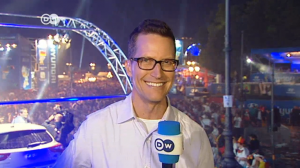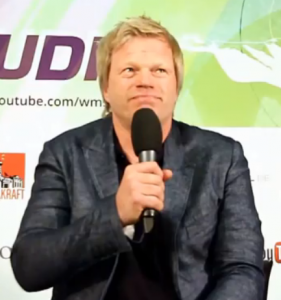Tips for journalists reporting on camera
 When journalists first get in front of the camera to report from the field, they’re usually so worried about what hand to hold the microphone in or whether they should use a notebook that they can’t concentrate on what they want to say. To help calm those nerves, onMedia asked DW TV journalist and news anchor Ben Fajzullin to share the basics of what’s important when reporting on camera.
When journalists first get in front of the camera to report from the field, they’re usually so worried about what hand to hold the microphone in or whether they should use a notebook that they can’t concentrate on what they want to say. To help calm those nerves, onMedia asked DW TV journalist and news anchor Ben Fajzullin to share the basics of what’s important when reporting on camera.
Using microphones on camera

Don’t hold your microphone over your face like former German goalie Oliver Kahn
Hand-held microphones give you an air of authority at the scene – it looks like you are in charge and know what’s going on. This is why hand microphones are often used when a correspondent is reporting live to the studio. A hand-held microphone also allows you to easily conduct interviews in the field. You can do interviews with a lapel mic but the hand-held mic puts you more in control as the interviewer. Just make sure you don’t forget to pull the mic back to you when you ask a question. If it’s a really noisy situation, a hand-held microphone is preferable.
Holding the microphone: You need to hold the mic about a hand’s width away from your mouth below your chin. Hold it in the hand farthest from the camera so that you don’t mask your body or turn your back on the camera when moving the mic back and forth between you and the interviewee. It’s usually more comfortable to hold the mic in your writing hand. But you may prefer to have that hand free to gesture or hold something else, like your notebook. It’s up to you.
Disadvantages: You only have one hand free, which can make you look stiff. You also have less freedom to move around, making the report more static.
What to watch out for: Don’t cover up any part of your face with the microphone – it looks horrible on camera. Here’s an example where both the host and the interviewee, Oliver Kahn, cover their faces with the microphone. Just terrible.
A lapel microphone is often better than a hand-held microphone for reporting from the field because it leaves your hands free to gesture or to use a prop relevant to your story. If you have a radio lapel mic, that is one without a cable, then you can also move around more easily, making your reporting more dynamic.
Disadvantages: Unlike a hand-held microphone, you can’t speak directly into a lapel microphone, which you might want to do if your surroundings are really noisy.
What to watch out for: Like the hand-held version, a lapel mic needs a fluffy wind protector so it doesn’t pick up excess wind sound. Make sure the microphone doesn’t brush against your collar or any other clothing as this can make an awful noise. Also don’t forget that if you want to point out something on camera and you physically turn your head to look at whatever you are pointing out, then the microphone won’t pick up your voice as well when your head is turned away. Notice how the sound levels continually shift as the correspondent moves his head in the following example.
Moving your hands on camera
The more you move your hands, the better because then your whole body will move, which is more natural. You don’t stand completely stiff when you tell a story to a friend, so you shouldn’t on air either. On the other hand, you don’t want to use exaggerated gestures for every single word. You can also use your hands to visually lead the viewers to something relevant to the story – you gesture to something and the camera operator sweeps to it at the same time, as in this example.
What to watch out for: Whether or not your hands are in the shot. Normally, the camera operator can flip the viewfinder around and show you how they’ve framed the shot. If it’s just a head and shoulders shot, then you know you have to bring your hands up into the shot if you want to use them. Hand gestures can also be used to emphasize a key phrase or word in the story – but make sure you don’t end up emphasizing every third word; vary your movements instead.
Moving on camera
If you have the chance, it’s always better to move around with the camera – it makes your report more exciting and reveals more of the scene. For example, you can say, “over here we have some fans from Germany” and the camera operator moves with you. A crime scene is also good for that kind of thing, because it allows you to move from room to room or within a room and you can break eye contact with the camera. You don’t want to come across like a deer in the headlights and stare into the camera the whole time. Even if you are working as a VJ and don’t have a camera operator with you, you can set up the camera and walk towards it while you are talking. It’s nothing new, but it still adds a bit of dynamism.
What to watch out for: Don’t walk in circles; it’ll just make the viewer dizzy. Too much movement or wonky camera work can also make the viewer giddy. Any walking needs to be much slower than your typical walking pace otherwise it looks like you’re racing to get somewhere.
Using props on camera
Props can really liven up your report. They add an interesting visual element – after all, the strength of video is that viewers can see what you are talking about. A prop can be anything from a book to a chocolate bar, or even a rubber bullet as in this report. Look at your prop as you talk about it or even take a chance and move with the prop. For example, in a report on gasoline prices, I once did a stand-up to camera while filling up my car, getting in and driving off (see below). Simple but effective.
Using a notebook on camera
A notebook is handy if you are reporting live on a story with lots of numbers or are going to read out a quote. After all, journalists need to be accurate. When I worked as a business reporter for Reuters, I always used a notebook – but they told me to look at it as little as possible. A notebook can also be used as a prop – it gives you a chance to look away from the camera for a second.
What to watch out for: Constantly referring to your notebook while you are on camera is distracting and can lead to a stilted report. Live reporting should be more of a conversation – you want to be chatting to the person in the studio, rather than reading off something you have written down. So don’t look at the notebook too much. Don’t forget you can also move the hand holding the notebook but don’t do it so often that the notebook becomes the center of attention.
Dealing with distractions
Distractions off camera: If something happens that isn’t in shot, you can probably ignore it unless it’s something significant like a bomb or a earthquake (watch this pro as she keeps her cool and keeps reporting as she has tear gas fired at her). Otherwise, keep your eyes focused on the camera and don’t swivel your eyes over to look at whatever is going on. Once I was doing a live cross from the 2006 World Cup in Germany and a group of people started annoying me – one guy was tickling my feet, while someone else was poking me in the butt with the end of his flag. The camera was shooting from below to show the stadium behind me so they weren’t on camera and I just had to pretend nothing was happening.
Distractions on camera: If something happens that the camera can see, then you can try to refer to it in your report. If someone jumps right in front of the camera, you can always say, “Look at this guy, he’s over the moon” or at least mention how crazy the atmosphere is. If someone blows a loud horn at a protest, then say, “It’s so loud here I can hardly hear myself think.” It’s good if you can tie it in. This is also when you hope you have a good anchor. Another time when I was reporting live from the World Cup, some British football fans started dancing behind me. Our anchor in the studio said at the end of my report, “I see you have two new friends there, Ben.” It was a clever way of incorporating what was going on.
Keep your face free
Obscuring any part of your face is annoying for the viewer. This means keeping the microphone out of your face under your chin and also not wearing sunglasses or a hat of any kind. Make sure your hair isn’t hanging in front of your face. If it’s windy, tie your hair back before you go on camera. Here’s an example of where the journalist definitely needed a hair tie. But if your hair blows in front of your face while you are on camera, just tuck it behind your ears in a natural movement (this correspondent does it very naturally – start watching at 3’15). There is nothing more distracting than if your hair blows in front of your face and you pretend nothing has happened – that’s really quite unnatural.
Get there early
It sounds so obvious but you need to get to your location in plenty of time to set up, gather your thoughts and be relaxed. Once I had to report on a case where a mass murderer had just committed suicide in a forest. It was up a big hill and I arrived just as I had to go live. I hadn’t caught my breath yet and I had to gulp for air every few seconds. The report went something like: “Just minutes ago, GASP, police put the body GASP into a body bag GASP”. It sounded awful. You don’t want to sound like you’re about to die!
On that note, be as natural as you can on camera. If you are yourself and have fun, the viewers will have fun with you.
Ben Fajzullin is an experienced journalist and news anchor who has worked for many broadcasters, including Reuters TV, BBC, Germany’s ZDF and SBS in Australia. He’s currently an anchor for DW TV’s main news program, Journal. If you have questions for Ben about reporting on camera, you can contact him through DW Akademie’s Facebook page.
SEE ALSO:
Writing good introductions for TV reports
The art of being persistent in an interview
Using graphics in your video and using them well
Edited by Kate Hairsine and Kyle James



